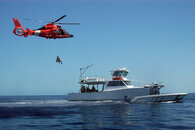the scenerio was based on a double fatality last mini-season (see
http://scubaboard.com/showthread.php?t=190716 july 27) a diver was found deceased on the surface with a fully inflated bc, her buddy was found 3 days later. The autopsy showed that she had died of an AGE, presumably something had happened to the first diver and she had panniced and bolted to the surface.
Victem #1 in our scenerio was found by our students on the surface with bc fully inflated. victem was paralyzed on the left side. victem kept saying incohearently about his buddy on the bottom. Our students quickly got vic #1 (now patient) on board and began administering O2. The students (9 of them) organized themselves (staff would only observe) they needed to render first aid, contact emergancy help (the capt. would handle the radio but not until the students directed him to, and only the info that the stundents gave him) prepare the vessle for the helo and search for the missing diver.
The search would be fruitless, there was no diver to be found. A manaquin was used and placed a mile down current. The search was ended upon arrival of the sheriffs office boat. The sheriffs office (SO) used this as an opportunity to train with there new sidescan sonar. The SO located, "bagged" and recovered the manaquin.
Mean while back on the NOAA boat:
Students managed the patient, whom was suffering from an AGE, while they waited for the arrival of the helo (students were not told prior to the scenerio the the coast guard wuold deploy a helo, although in class we had talked about preparing a vessal for both boat tranfers or air lifts). A doctor who is also a scuba instructor follows the patient and gives "vitals", signs and symptoms when ever they are taken. The doctor will change these depending on the treatment the patient has recieved.
Upon arrival of the helo the captain was instructed to hold a steady course and the helo would match speed and heading for the deployment of their medic. The students then needed to "hand off" the patient to the medic reporting what they were deailg with. The students assisted in packeging their patient into the baskit (exciting stuff

). Then the helo took off.
At this time the students were transferred to SO and FWC gofast boats (zoom, zoom

) and hitailed off to shore. The helo made a stop at the Naval air station to refuel ggiving the students and the Dr. time to get to the Hospitol befor the helo landed there.
At Lower Keys medical center the patient was recieved by a ER Dr that was told that he was in a drill, but not what type of patient he was recieving. The only info he would recieve would be hand off info from the medic ( that he got from the students) and any test results (given by the Dr following the patient) that he ordered. He was assisted by FKCC nursing students). The DR made the correct diagnosis of AGE and ordered immediate recompression. The value of this part of the drill is the rescue students can see the mportance of their early treatment and the importance of keeping notes to send along.
The patient was the transported via Key West Rescue ambulance manned by EMT students to FKCC hyperbaric Faccility and recieved by a hyperbarric nurse, tender and Dr. A nueral exam was given and a table 6 was called for. The patient was loaded into the chamber with a tender (suspiciously clad in scrubs covered in turtles

) and taken to depth. The chamber was opporated by chamber students. Once at depth the scenerio was over and the patient and tender were brought back to the surface happy and well.
All in all a good days work.
trtldvr
www.divealive.org
ps. The entire scenerio was filmed by NOAA to be used in Waterways, thier cable TV show. The show is broadcast in South Florida. This eppisode should be broadcast some time in June.




 ) and hitailed off to shore. The helo made a stop at the Naval air station to refuel ggiving the students and the Dr. time to get to the Hospitol befor the helo landed there.
) and hitailed off to shore. The helo made a stop at the Naval air station to refuel ggiving the students and the Dr. time to get to the Hospitol befor the helo landed there. 